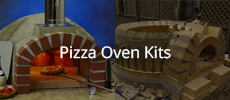Announcement
Collapse
No announcement yet.
39 inch - 1000mm corner brick WFO build - Newcastle au
Collapse
X
-
I noticed an earlier pic of the footing, blockwork and slab sizing is not showing from earlier post, so additional copy attached FYI.1 Photo
-
The wet ready to go mortar in the bucket sounds like a sodium silicate based mortar. The “fondu mortar” sounds to me more like Ciment Fondu which is calcium aluminate cement, not a premixed mortar. It requires the addition of a fine aggregate to create a mortar and what you have described that you did by mixing the 3 parts washed sand to it. Because it reacts far faster than Portland cement there is no need for extended damp curing.
Leave a comment:
-
Just filled up the backs of the dome bricks tonight with a different mortar supplied with kit called "fondu mortar". Still high temp rated but supposed to be better for larger gaps. Mixed with washed brickies sand 1 part dry mortar to 3 parts sand, just enough water to make mortar like consistency when mixed. Much easier to fill the gaps than laying the bricks, especially when outside will be covered later anyway...3 Photos
Leave a comment:
-
Another course of fire bricks on the dome done last week. The mortar supplied for the inside of the dome is pre-mixed and called "airset mortar". High temp rated to 1500 degrees celcius and recommended for max 5mm gaps. When you open the buckets there is liquid on top and the mortar is a hard dense blob almost too hard to mix. Once you start mixing it up it eventually gets to a mortar like consistency. Glad I bought a mixing attachment for my spade handle drill to help with this process.6 Photos
Leave a comment:
-
Nice work on tapered inner arch. This concept is one of the most difficult for builders to visualize.
Leave a comment:
-
Got the base layer of insulating fire bricks, entry arch and next 2 courses of fire bricks mortared down. I'm definitely not a bricklayer, but happy with way it is going together so far.6 Photos
Leave a comment:
-
Did a mock up of everything before I started mortaring it together5 Photos
Leave a comment:
-
A bit more progress on the WFO build over weekend.
Cut out the sheets of 50mm calsil board around the shape of the floor tiles.
4 Photos
Leave a comment:
-
Stripped the formwork today, came up pretty well I think. For anyone planning a similar insulating slab, mine came out 1250mm wide overall, depth to front of landing approx 1675mm, with stepped landing widths of 610mm and 835mm at door entry. Used around 3 x 20kg bags of cement and 3 x 100 litre bags of 3-6mm perlite with 5:1:1.5 perlite/cement/water ratio mix.3 Photos
Leave a comment:
-
That is a good solution then. Looking forward to the rest of your build. While on insulating fire bricks for anyone reading this thread, they can be obtained free. Be on the lookout for old pottery kilns, particularly from schools that have had operators who’ve not been experienced and therefore not looked after them. I’ve salvaged a couple. The bricks are easy to cut by hand or crush to make insulating aggregate.
Leave a comment:
-
Thanks for the feedback and tips. Re the insulated fire brick as first course, once I add the internal 50mm calsil board and the 50mm thick fire brick floor tiles, this will mean the 75mm high IFB to the perimeter will be around 25mm lower than the finished oven floor and won’t be exposed. The next courses of fire bricks are the heavy duty dense ones. I am a bit lucky re the corner build as I will have a ramp beside the oven and access behind it at a higher terrace. At this stage I am not going to build an enclosure and will just rely on some water repelling render or coating to outside of the WFO. Cheers, Brad
- Likes 1
Leave a comment:
-
David brings up a good point on the softness of IFB. I was thinking by you adding 90 mm pcrete under CaSi plus floor brick thickness the IFB would not be exposed on the inside of the dome. Just something to keep in mind
Leave a comment:
-
Hi Brad,
That looks like a great build. Three things to consider.
1. Corner builds do present some problems. If the wals at the corner are higher than the base, working around the back of thr oven becomes quite difficult, so either don't build them up, or wait until you've completed the oven. The other problem is that it creates a corner at the back of the oven that becomes pretty useless and hard to access as well as being a harbour for dirt and leaves that is difficult to clean out easily.
2. vermicrete takes up a lot of water as you've found. A high proportion remains as free water and as wet insulation does not work well its elimination is important. This is far more difficult to achieve once it's built over. Check my drying test here.
Vermicrete insulating slab copy.doc.zip
Also here
https://community.fornobravo.com/for...045#post411045
3. As IFBs have very low density which gives them good insulation value, along with that comes low strength. The 30mm or so of exposed IFB inside the inner dome at its base will be quite vulnerable to damage with a metal peel, so you will need to be mindful of this when operating the oven.
Thanks for your diligent documentation. This is what makes the forum such a great resource for others.
DaveAttached FilesLast edited by david s; 06-29-2024, 01:37 PM.
Leave a comment:
-
Hmm, never thought about using IFB under the first course if you take dome to hearth floor. An innovative idea, a little more spendy than using pcrete or CaSi but a good alternative none the less. We have seen a few builders lately placing the dome bricks right on the concrete hearth. If one is spend all the time and money to build one of these beast, why not make if a efficient as possible without breaking the bank.
Leave a comment:





Leave a comment: